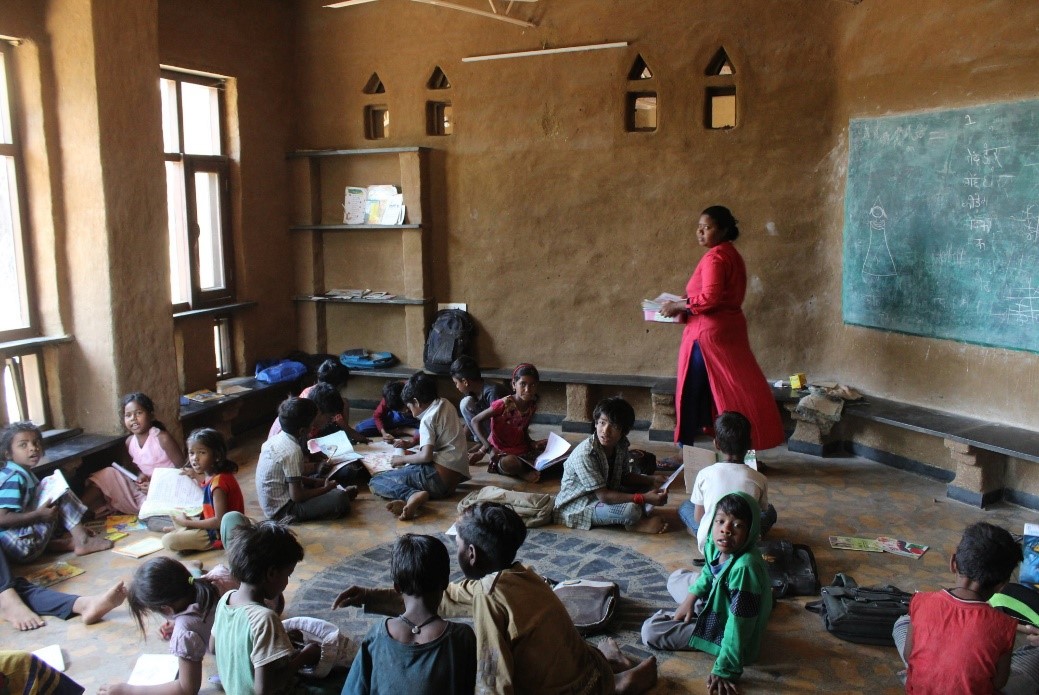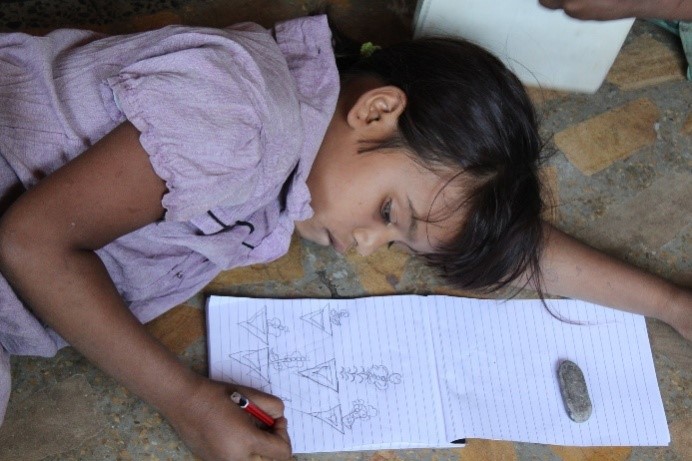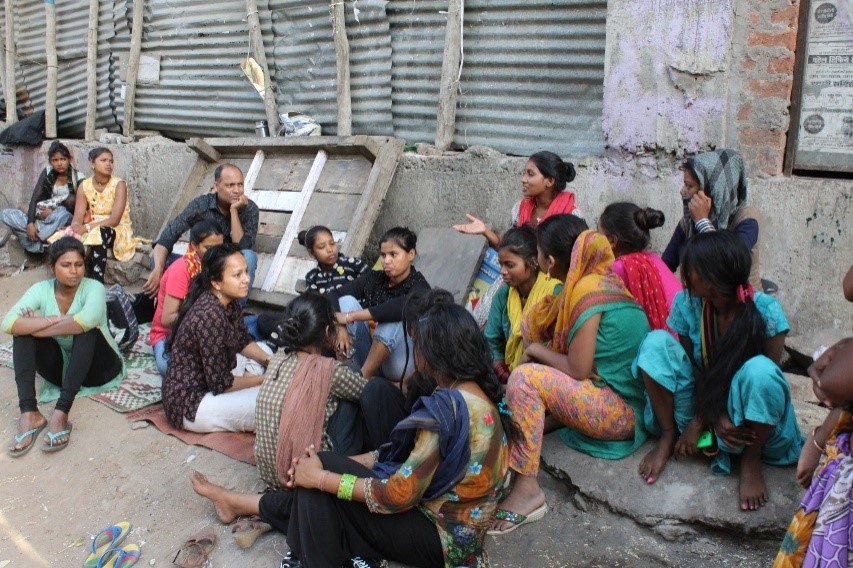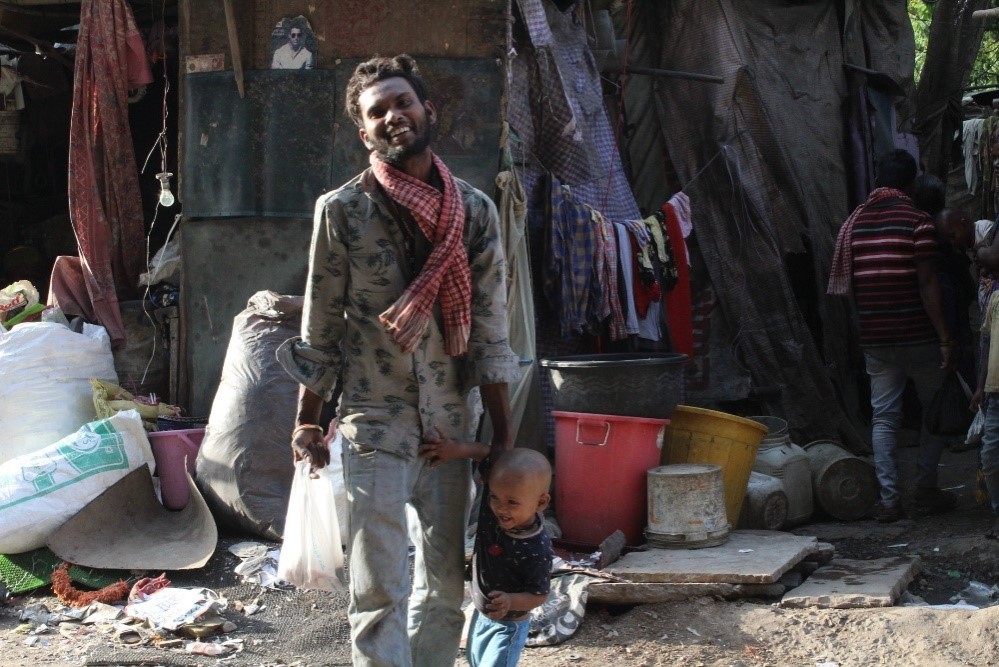Practice Insights > Lessons From Practice > Education
The Promise of Education in the Lives of Urban Adivasis: Lessons from Muskaan
By Ritika Gupta
1. Introduction
Many of us, when we see a child engaged in other activities during school hours, may wonder why the child is not in school. Universalisation of elementary education has fuelled the popular belief that all children must get formal education; this has, thus, lead to a surge in enrolment rates. While this, in itself, can be seen as a positive shift, there is value in thinking about the alarmingly high dropout rates. Why are all children not able to continue through school? What factors of the school environment are not conducive for certain children to remain in school?
This seems to have specific relevance in the education of children from the Adivasi communities. There is ample literature (Sundar, 2002) stating that school cultures and curriculum are not inclusive of Adivasis’ lives. We reiterate the importance of personalizing the pedagogical space while teaching young children because they learn by relating concepts to their own life. However, often, the content taught, language used, and the dominant culture of the school are incongruent with the realities of Adivasi children. How does a child then, integrate this learning with his/her own reality?
This article aims to capture Adivasi children’s and youths’ perception of education and their experiences of negotiating their identity in an urban setting.
2. Overview of work done by Muskaan
Muskaan is a non-government organization (NGO) working for the education of marginalized children in Bhopal, Madhya Pradesh. The organization works with vulnerable children and youth living in bastis in Bhopal on the issues of education, identity, violence, health, and nutrition.
2.1 Education
Muskaan’s primary focus is on the education of children unable to access mainstream schools. Initially, they worked with mainstream schools by assisting with children’s admissions and retention. However, the rampant discrimination and ridicule faced by the children from waste-picking backgrounds; the children’s own rejection of the system; and, poor learning in children who otherwise seemed to be competent learners, lead Muskaan to rethink its strategy towards universal formal education for all.
In 2005, Muskaan opened its school from grades I-V with the aim of providing a ready option for education to children and communities who are still not accepted by the regular school system. The organization also began working with government schools to enable them to be competent to handle diversity.
Apart from the school, Muskaan also conducts educational activities through learning centres in the urban bastis, runs Balwadis or early childhood education centres in the bastis, youth support classes for examinations in grades VIII, X and XII and provides access to libraries to children from 3 to 18 years and onward.


2.2 Engagement with the community
Muskaan’s strong relationship with the community often serves as a bottom-up approach in defining the focus and methods of their work, informing the organization about critical needs. Some examples include, empowering women to overcome discrimination; working with youth to be agents of change in their own lives and communities and contribute to the larger struggles for a just society for all; building and strengthening children’s collectives to enhance agency of children in society; and, striving towards building an effort for challenging social norms that go against children’s rights.
3. Conversations with Adivasi children and adults
What makes urban poverty a cyclical spiral is the irreversible dependence on a cash economy combined with the lack of assets and access to natural resources. Often physical space is scarce and living conditions are deprived in the bastis in terms of availability of toilets, drinking water and drainage. This combined with the increasing dependence on daily earning, daily threats to ones’ identity and the instability that comes with living in ‘temporary shelters’, cumulatively, takes a heavy toll on the everyday life of a person living in poverty in urban areas.
While conversing with some Adivasi children and adults, they were asked what it means to them to be an Adivasi living in an urban area. All of them stated that given a choice, they would want to return to their previous ways of living. Being in the city which does not necessarily have space for them makes them feel invisible, unimportant and stuck. There is a persistent feeling of injustice prevalent in all of them from being misunderstood and discriminated against. They also expressed that there is a certain comfort in being able to call a place ‘ours’, it gives the community a sense of belonging. But the city and the challenges it possesses is slowly gnawing away at that sense of belonging and identity. There is a constant tug of war between wanting to hold on to their Adivasi identity and culture, on one hand, and wanting to achieve success in the city on the other. Often when they try to retain culture-specific practices to protect their identity, they are judged and rejected by the mainstream communities, thus, reinforcing the prejudices held against them and making upward mobility a challenge.
Most of them expressed the hope that education will serve as their ticket to a better life. Education was almost romanticized as the solution to all the problems of marginalization, poverty, gender inequality and sound moral development. But the question is, can education alone address all or even one of these?
4. Perceptions of Adivasi children and adults on education
Conversations were held with children belonging to different Adivasi communities, either at their homes or at Muskaan. These children ranged from those who are currently in school, those who have dropped out, some who have finished their high-school and are now married in the same community and also, some who never went to school. These conversations brought up diverse perspectives of how these children and communities see education, what education has done to their lives and how they are negotiating their everyday lives. The aim here is to present these perspectives along a fluid spectrum; while some Adivasi populations appeared to be more open to education than others, there is a complex interplay of many factors; and hence, beliefs about education were never linear.
At a cosy house in Nehru Nagar, a group of articulate young girls, belonging to the Agariya Adivasi community, narrated their experience of going to school. Though each one of them had her own unique story, the underlying commonality was their persistence. Persistence to keep fighting for their right to education and a personal insistence of not allowing factors, such as poverty, gender, social and cultural expectations and disappointments from the mainstream world, control the course of their lives. Some girls shared just how many times their family or the community panchayat had forbidden further education, often for more than a year, and how each time, they renegotiated and got back. Muskaan, to them, was a huge support system which helped them not lose hope and supported them in navigating the times – carrying out some negotiations for them and at the same time, enabling them to fight some battles on their own.

This was in congruence with the experiences of some children who stay at Muskaan’s hostel to study. They expressed a sense of pride in being able to read and write, stating that education helped them in having a voice in their community. Others from the community, now often ask these children to accompany them to the doctor or the police station because they are perceived to have greater comprehending and articulation skills. The children are also often called upon to read or write out important documents and hence, are involved in matters of adults. This exposure into the adult world has added to their agency and presence in spaces which they otherwise would not have been a part of.
Children from different Adivasi communities expressed feeling more empowered in being able to assert themselves; they feel more competent to stand up for their rights, fight for themselves and others and voice their opinions to the community at large. The experience of education has also enabled them to critically reflect on the practices of their own community; for example, on the authority of the panchayat as a decision-making body.
After speaking with these children, one cannot help but wonder what is it that these children see in education, which drives them to fight for their right to it with anyone that seems to come in way of it? What hope does the promise of education bring to populations who have not even experienced it, or have experienced only despair in the system? It seemed as though most children see education as a glimmer of hope of a better future. What stands out is that often these children coexist with others who have finished their grade VIII and are back to living the same lives, and even that does not deter their drive to study.

| Girl 1 (grade XII pass, now married) “Sab karke, wapas yahi aa gaye didi, wahi pichri soch, kachra uthana. Muskaan ke baad sab karab ho gaya (points towards toddler.” (After doing everything, I am back to the same life, the same backward thinking, picking up garbage. Life after Muskaan has gone downhill.
Girl 2 (in grade XI) “Didi, main toh barvein tak padhungi, fir college bhi jaungi aur badi building wale office main Naukri karungi. Yahan se nikalna hai bas, Manager banungi, didi. Aapke office main mujhe padhyenge?” (Didi, I will complete my 12th and then go to college and then work in one of those offices in big buildings. I want to get out of here. I will become a manager. Will they let me study at your college?) |
For example, children from the Ojha Gond community residing in Gautam Nagar expressed that in their tribe, they were free to do whatever they wished; most people got married to who they wanted to and could study if they wished to. The discussion group had two distinct categories; one group of girls were in school, and the other had finished studying and were married within the community. Even in the same community, there were stark differences in the perception of the value of education. While the young girls were full of aspirations and held on to the belief that education was definitely their ticket out of this cyclical poverty, the older girls expressed despair and helplessness having come back to the same life after getting educated.
Examples of the lives of these individuals add to the belief held by some that education does not change anything. While at the one end of the spectrum lay glittery eyed-individuals with hope in education, at the other end of the spectrum lay, parents, panchayat leaders and some children who were staunchly against education. Children from the Pardhi community did not want to go to school for the fear of being beaten up; many students stated that they were discriminated against; termed as thieves, always blamed when something went wrong and always allotted jobs of cleaning dustbins and bathrooms. Parents stated they were scared of violence as physical fights break out between boys very often and hence, they preferred to not send their children to school.
The ingrained discrimination and dominant stereotypes that exist in society against certain Adivasi populations make life at school a challenge. Discrimination presents itself at so many levels that breaking out of it is a continuous battle; these people felt that the justice system too was partial, and baseless arrests are a common occurrence in their everyday lives.

In other Adivasi communities, parents expressed their fear of children becoming misfits after getting an education. Often children became more adamant (‘bigad gayi’), argued and demanded more agency after studying. Some start protesting against certain community practices like the Panchayat making decisions or against child marriage. Parents felt that the child did not feel happy living in the space anymore, but at the same time, education alone could not enable them to leave this space. The popular notion and experience of many elders in these communities was that education does not really change anything concrete; children still come back to the same life, same occupations. Very few have been able to break out of this cyclical life. Hence, sending boys to school came at a cost of them not knowing their trade and delaying their ability to earn by many years. For girls, on the other hand, it came at the cost of getting married a few years later than is the norm. These notions, interestingly, lead to communities being more open in allowing girls to go to school (at least primary school) than boys.
What was remarkable though was that children who were in school, recognized these feelings felt by others and acknowledged these realities. Some even extended empathy towards members of their own community stating that they understand why people are scared and wary of these paths. They understand where the fear comes from but still choose not to give in to their fears.
| “Didi bare shehar main aake chezon se nahi darenge toh zinda nahi rahenge. Who aisi daar se kehte hain kyunki unko humari fikar hai. Par hum larenge, sirif jab hum lar ke yahan se nikal payenge, tabhi hum dusron ko aapne saath le ja sakte hai.” (Didi, if one doesn’t fear things while moving to a big city then one will not survive. The elders say these things out of fear because they are worried for us. But we will fight, because only when we fight our way out of here can we try and bring others out.) |
5. Transition to mainstream schools
Most children studied in Muskaan till grade V, after which they were enrolled in government schools and were supported by Muskaan. All of them expressed a stark contrast in the experience of learning in the two spaces. At Muskaan, when children came in, they were free to use their own languages in talking and writing. This helped in not only sustaining their interest but in building curiosity and enthusiasm to write. Empowered with this foundation of feeling accepted and competent, and; given the innate curious nature of children, they were quick to learn each other’s languages. Moreover, the pedagogy adopted by Muskaan is grounded in the children’s context and weaved in the songs they sing, the struggles they engage with, the aspirations they have – of becoming a lawyer, a teacher or a youth facilitator. Muskaan’ s hope is that the education provided helps the children to critically understand the world and their own communities and to contribute to making a better world.
The children felt that this personalization of pedagogy and agency, given at Muskaan, was completely absent in the mainstream schools and hence, many of them felt that further education would not add any value.
| Searching for spaces and opportunities that provide respect A young woman (Girl 3) in her early 30s, shared that she had two children and now was studying to give her 5th standard exam along with her son. She hoped that a 10th pass certificate would help her change her job as a domestic help to a job in a shop or office as she associated the latter with more respect. This search for spaces and options which provided dignity and respect was also true for her children. She expressed that she had removed her children from the government school and admitted them in private school because: “Didi, padhai ka toh mujhe pata nahi, par kam se kam mujhe aur mere bacche ko izzat milti hai. Kis maa baap ko acha lagega ki uske bacche ko mara jaye ya neecha dikhaya jaye?” (Didi, I don’t know about the academics, but at least, I and my child are given respect. Which parents would like that their child is beaten and demeaned in school?) |
Dominant themes of difficulties faced in transition revolved around feeling restricted to ask questions, lack of respect, incompetency of teachers, discrimination and general school environment in the mainstream schools. Out of all these, lack of respect and dignity seemed to colour all their experiences.
6. Implications on the education system; pertinent questions
There exist polarized views on how Adivasi education should be constructed; varying from advocating for residential schools given the inherently constraining realities of Adivasi children to gain an education, to advocating for the preservation of Adivasi spaces and culture and hence, focusing on a more inward, in-community approach to education (Bagai&Nundy,2009). Muskaan seems to be following a middle path wherein it provides children who have very difficult home environments access the residential facility to study but at the same time, all children are required to go home on the weekend. They assert the need for children to maintain their connection with the community and its customs. Other children are educated within their communities and provided with routes to access formal systems while enabling them to advocate their own identities in mainstream societies.
It is important to explore how the promise of education impacts deprived communities. The general essence of various Adivasi communities visited was education-positive; most families wanted their children to study because it was seen as a gateway to higher education, higher-paying jobs and improved social status. Everybody agreed that basic literacy was useful in their everyday lives, jobs and confidence levels. Yet, the process of attaining even basic literacy was traumatic for most, often causing many to drop out. This raises the question of whether children should be forced to go into spaces which do not respect their identity and be forced to learn information which has no relevance to their realities.
While enrollment can be seen as the first step, energy and resources now need to explore sustainability – how can we build mechanisms in our schools to cater to India’s diversity and sustain children from various backgrounds?
These are pertinent questions which have been dwelled upon by many in the education field, however, there is a need to hear more voices of Adivasis themselves. The absence of their voice in matters concerning their own lives adds to the significant gap in our understanding and formulation of what needs to be done in the education of urban Adivasis.
Given the relentless drive to gain education reflected in the conversations with the Adivasi communities, one has to consider that there must be some value that education is adding to their lives, expected or actual. There is a clear indication that education did make the children more competent in negotiating their everyday lives. However, there is a very real need to explore how curriculum and pedagogy can be made more inclusive of Adivasi lives and to shift the focus from mere enrollment to exploring ways of sustaining them in school.
AUTHOR
Ritika Gupta, Faculty, Azim Premji University
References
Bagai, S., & Nundy, N. 2009. Tribal Education.
Sundar, N. 2002. Indigenise, nationalise and spiritualise–an agenda for education? International Social Science Journal, 54(173), 373-383.

